The decision between a kneeling chair and a standing desk when it comes to designing a functional and ergonomic workstation has generated interest and discussion. These two options have grown in favor because of their potential advantages as more individuals place a higher priority on their health and look for alternatives to standard seated positions.
Table of Contents
However, choosing the best alternative necessitates carefully weighing several aspects, such as posture, comfort, and personal demands.
We’ll review the benefits and drawbacks of both kneeling chairs and standing desks in this conversation to help you decide which would be the best fit for your office furniture and personal preferences.
We can discover the prospective effects on productivity, posture, and general wellness by comprehending the distinctive characteristics of each.
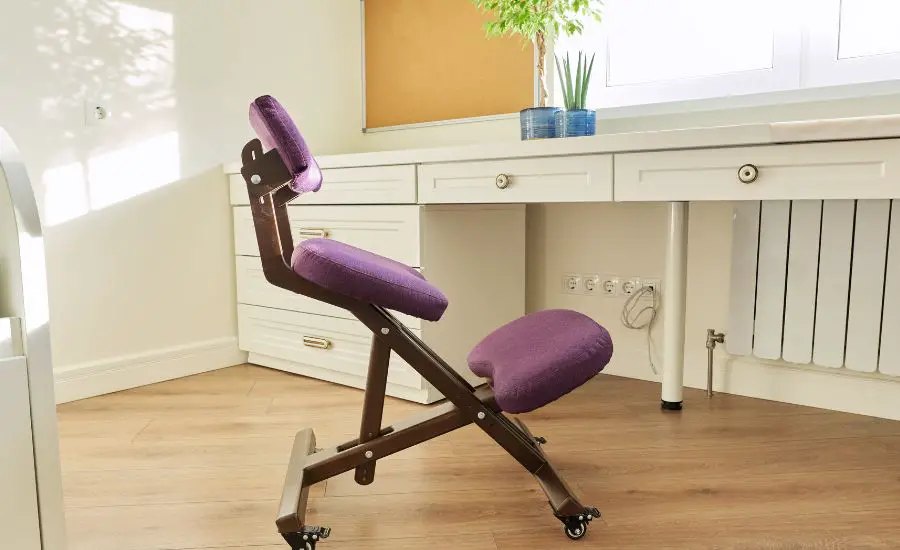
Kneeling chair vs Standing desk: posture
There are several things to take into account when evaluating a kneeling chair and a standing desk.
Compared to traditional chairs position, both a kneeling chair and a standing workstation encourage improved posture.
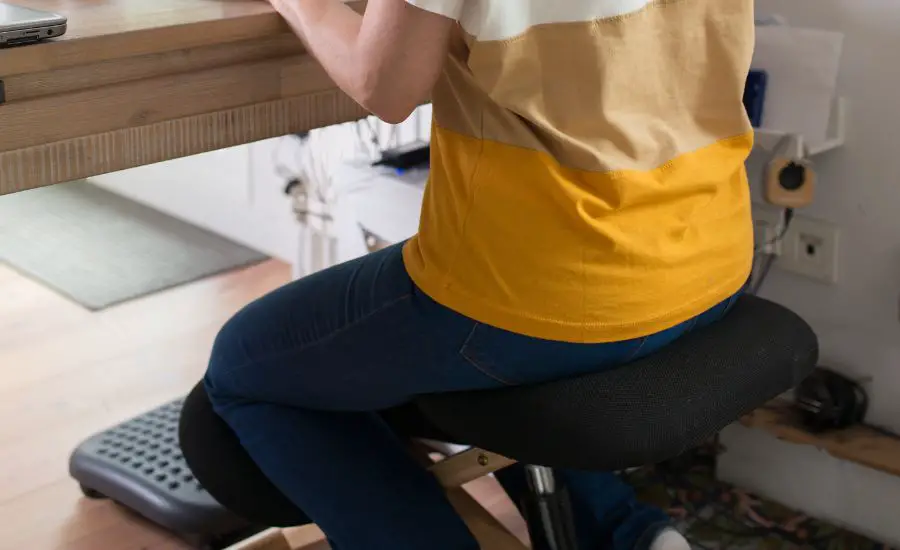
Kneeling chair: open hip angle, upright posture, engaged core
An open hip angle and an upright posture are encouraged by a kneeling chair, which can assist in straightening the spine and reduce pressure on the lower back.
Standing desk: weight distribution, engaged muscles of legs and core
Many standing desk users use a fixed-height standing desk to support an upright posture, which can lessen slouching and support a more neutral spine alignment.
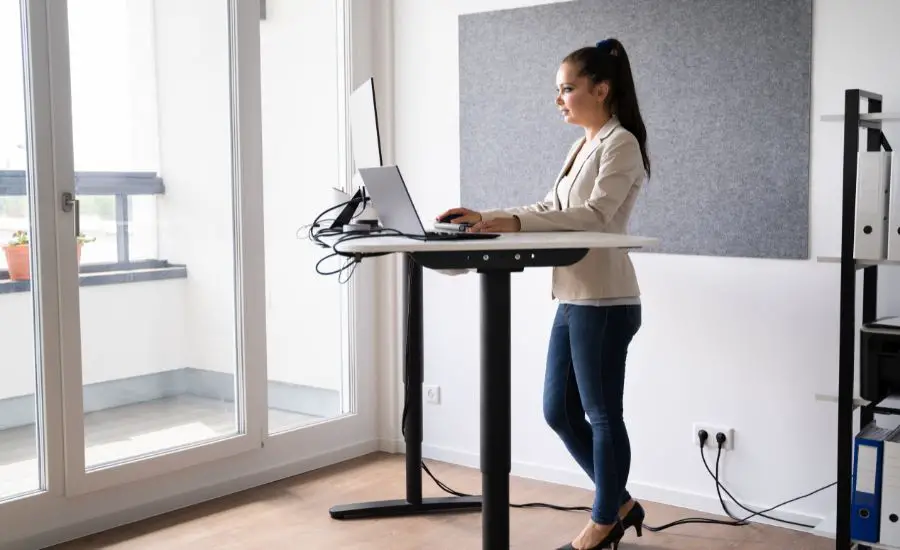
Muscular engagement
Muscle engagement differs between using a kneeling chair and a standing desk.
Kneeling chair: core muscles, quadriceps, glutes, lower legs
kneeling chairs offer active sitting by involving the core muscles.
To be stable while kneeling, the abdominal and back muscles must be continuously contracted.
Standing desk: ankle stabilizers, postural muscles, core and leg muscles
Numerous muscle groups, such as the leg, hip, and core, are also used when standing at a desk as people strive to keep their balance and stability.
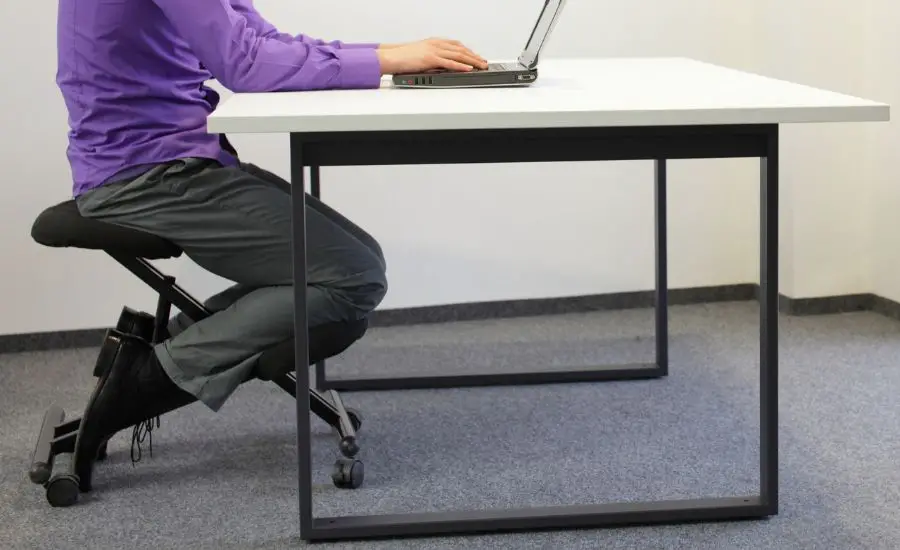
Movement
The pattern of movement differs between kneeling chair and standing desk.
Kneeling chair: weight shift, kneeling pad adjustments, core activation
The movement is very limited in this office chair.
Standing desk: postural changes, active breaks, stretching
Standing at a desk permits more movement than kneeling on a chair.
Even while using a kneeling chair encourages active sitting, the position is still more static than when standing at a fixed-level standing desk.
Standing at a standing desk converter gives you greater freedom to move around, change postures, and include small movements throughout the day, which can help you be less sedentary and increase blood flow.

Comfort and fatigue
Long-term usage of a kneeling chair may also result in pain in the lower legs, including the knees, shins, and lower legs.
To reduce any potential discomfort, it’s crucial to pay attention to your body and strike a balance between sitting and standing, taking breaks, and changing your posture.
However, for some people, prolonged standing might cause leg tiredness and pain
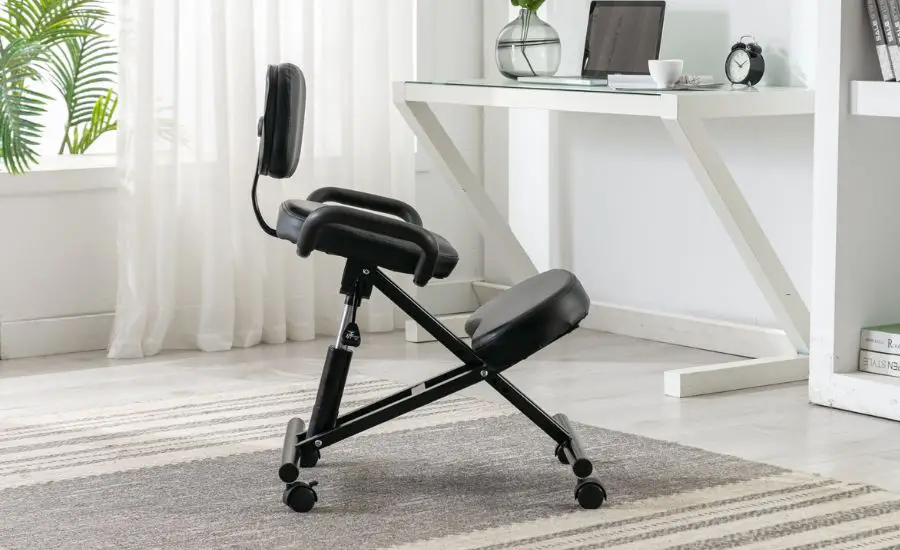
Work tasks and space
Your decision between a kneeling chair and a standing desk may be influenced by the kind of work duties you undertake and the available area.
Kneeling chair: more accurate tasks
It might be a better choice for tasks that call for more stability and accuracy.
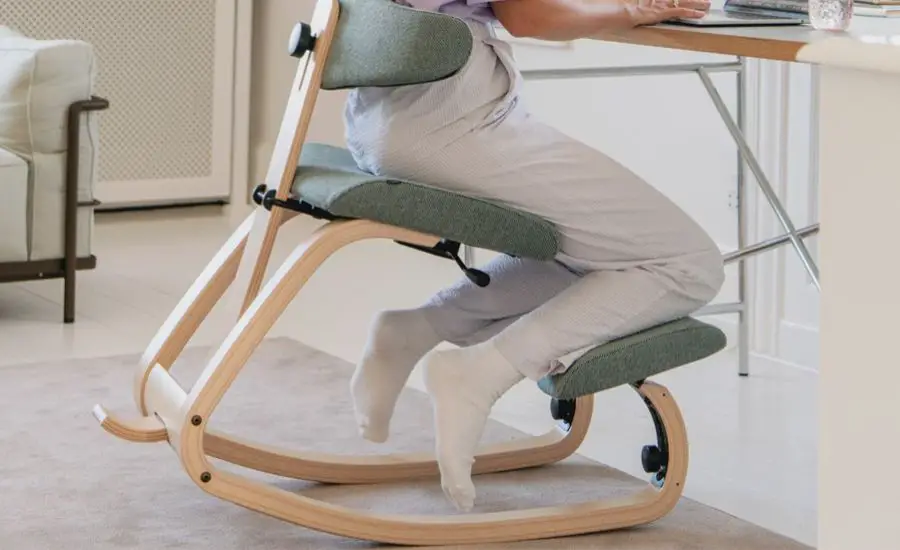
Standing desk: more access to bigger workplaces
A standing desk converter might be more appropriate for occupations that need more movement or access to a bigger workplace.
The decision between a kneeling chair vs standing desk ultimately comes down to your tastes, job demands, and level of comfort.
It may be best for some people’s general health to combine the two strategies or alternate between sitting and standing throughout the day.
It’s crucial to take into account your unique requirements and consult with medical doctors or ergonomics experts to find the optimal workspace solution.

FAQ
Is a kneeling chair better than a standing desk?
Whether a kneeling chair is better than an electric standing desk depends on personal tastes, demands, and unique health factors.
Each choice has benefits and drawbacks of its own. While some people might prefer the flexibility and movement options offered by a standing desk, others might find the posture and comfort benefits of a kneeling chair to be more useful.
To decide which alternative would be ideal for your office furniture, it’s crucial to take into account your particular needs and speak with a healthcare practitioner or ergonomics expert.
What is the downside to kneeling chairs?
While kneeling chairs provide advantages, there are some drawbacks to be aware of as well:
Limited ergonomic support
Kneeling chairs often don’t have backrests or armrests, which might be a drawback for people who need extra support because of particular conditions or preferences.
Adjustment period
Getting acclimated to a kneeling chair can take some getting used to for your body, especially if you’re used to standard seating.
Until your muscles adapt to the new sitting posture, you can first feel soreness or weariness.
Pressure knees and shins
Kneeling chairs put more weight on the legs than traditional office chairs do, especially the knees and shins. You must make sure that the chair’s cushioning or the knee pads are sufficiently padded and supportive.
Limited versatility
Kneeling chairs are primarily made for kneeling to sit in. For occupations that call for diverse positions or movements, such as computer work, kneeling chairs might offer a pleasant and ergonomic posture, but they might not be as adaptable.
Not for everyone
People who have specific medical disorders, such as knee or hip problems, or who have trouble kneeling or rising from a kneeling position may not be ideal for using kneeling chairs. Before selecting a kneeling chair, it’s crucial to take into account personal preferences and any current medical concerns.
Is it OK to use a kneeling chair all day?
For most people, sitting in a kneeling chair all day is not advised. While using kneeling ergonomic chairs designed by experts exclusively for an extended period can have possible risks and may not be ideal for everyone, kneeling chairs can help ergonomics and encourage better posture.
Here are some things to think about.
Comfort and fatigue
Extended kneeling can cause pain and exhaustion in the lower legs, especially the knees, shins, and lower legs. To prevent undue strain, it’s crucial to pay attention to your body and take breaks or alter postures frequently.
Muscular stress
Muscle fatigue and stress might result from repeatedly using specific muscle parts when knelt. To evenly disperse the effort across different muscles throughout the day, it is advised to integrate exercise and change your posture.
Lack of back support
Rocking Kneeling chairs sometimes don’t have backrests, therefore they don’t offer back support.
Increased strain on the lower back and discomfort may arise from this, especially for people who need back support because of underlying conditions or extended periods of sitting.
Range and movement
To enhance circulation, lower the risk of muscle imbalances, and prevent stiffness, it is typically advised to integrate a range of postures and motions throughout the day. If you only use a kneeling chair, it could be more difficult for you to change between sitting, standing, and other positions.
Consideration
Individual criteria, such as your physical condition, level of comfort, and work requirements, will determine whether using a traditional kneeling chair all day is appropriate for you. To find the finest seating solutions for you, it’s crucial to think about your requirements and speak with a healthcare practitioner or ergonomics specialist.
How to incorporate movements while using a standing desk?
It’s essential to incorporate movement while using a standing desk to maintain comfort, lessen fatigue, and advance general well-being.
The following advice can assist you in adding activity to your standing desk routine:
Stretch and move at your desk. You don’t need to leave your desk to incorporate movement, so stretch and move around while you’re there.
Simple stretches and exercises can be done while standing at your desk. Stretch your neck, legs, shoulders, and arms.
Gentle twists, leg swings, or calf raises should be performed. These exercises can promote circulation and help reduce stiffness.
Use a footrest or balance board. Adding movement and engagement to your standing position is possible by using a footrest or a balance board.
Using these devices with standing desks while standing enables you to change your weight, extend your legs, and activate your leg muscles. They encourage light movement and lessen weariness.
Walk or pace while on calls. When on calls, walk or jog around your workstation. If you have the time. use phone conversations or video conferences to your advantage. To keep your hands free while operating a speakerphone or wireless headset, move about.
When performing sedentary work, walking or pacing might help to improve circulation and keep you engaged.
Think about using a treadmill with standing desks. Standing desks with a treadmill attachment can be an alternative for people who wish to add more movement to their workday.
As a result, you can move slowly while working. It’s crucial to check that you can retain concentration and complete your work efficiently while walking, though.
How long should you sit in a kneeling chair?
The length of time spent sitting in a kneeling chair might vary based on personal preferences, level of comfort, and work requirements.
However, it’s generally better to integrate movement and postural adjustments throughout the day rather than being in one position for an extended period.
Here are some suggestions to bear in mind:
Regular breaks. It’s advised to take regular pauses from sitting, regardless of the type of chairs you use. Each 30 to 60 minutes, try to get up, stretch, and move around. These breaks aid with blood circulation, lessen muscle wear and tear, and avoid stiffness.
Postural variation. Think about alternating between several seating options rather than sitting in a tall kneeling chair all the time. Throughout the day, you can alternate between a moveable standing desk, a regular chair, and a kneeling chair.
Listen to your body. Pay attention to your body’s signals and modify the length of time you spend sitting. It’s crucial to take a break, swap positions, or think about using a different chair that offers the appropriate support if you experience any discomfort, weariness, or pain while using a kneeling chair.
Individual needs and preferences. Individual demands and tastes may influence how long someone should sit on a rocking kneeling chair. Some people can find sitting in a kneeling position for longer lengths of time to be comfortable and beneficial and that sitting in kneeling encourages proper posture, while others might prefer shorter times.
Take into account your degree of comfort, your physical health, and any specialized advice from healthcare providers or ergonomics experts.
Remember that the idea is to integrate regular movement and postural adjustments throughout the day in place of lengthy static positions.
Conclusion
The decision between a kneeling chair and a standing desk regular chair for your typical office chair comes down to personal preferences, job demands, and health considerations. Each choice has benefits and drawbacks of its own.
An alternative to conventional seating that can improve posture, include the core, and be more pleasant is a kneeling chair. However, it could need some getting used to, lack back support, and not be appropriate for everyone.
Standing desks like electric standing desks, on the other hand, enable postural diversity, reduce sedentary behavior, and may have health benefits. Standing desks encourages standing up straight and activity all day long.
Finding a balance between sitting, standing, and moving can be the best course of action. Using a variety of seating alternatives, taking frequent pauses, and changing your posture can all assist to reduce pain, improve circulation, and support overall musculoskeletal health.
it’s crucial to take into account individual demands, seek advice from medical professionals or ergonomics experts who will recommend an ergonomic office chair, and pay attention to your body’s signs.
You may design a workspace that supports your comfort, good posture, productivity, and general well-being by striking the correct balance taking your unique circumstances into account, and buying the discussed kneeling chairs and desks from office chairs nearby or forgo the kneeling chair altogether.